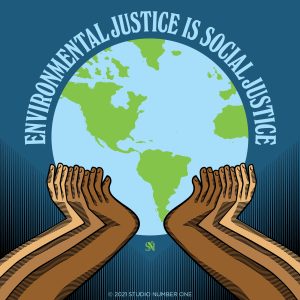12 Environmental Justice Introduction

(Center for Coalfield Justice 2023)
The Center for Disease Control defines environmental justice as “…the concept that all people have the right to live in a healthy environment, to be protected against environmental hazards, and to participate in decisions affecting their communities”. Overall health outcomes are negatively impacted by environmental factors. Environmental justice affects vulnerable populations at higher rates, with intersectional identities posing increased risk of health disparities. This chapter will delve into environmental justice at three levels: through the global lens, at the national level in the United States, and within the State of Iowa. (CJ)
Environmental justice is an essential issue within public health because it explores disparities different communities face related to the environment around us. Environmental justice offers a critical lens on social, economic, and political determinants of health. By addressing these determinants, we can improve the quality of life for entire communities and regions around the world and in our nation. Many may not think of environmental factors including water pollution, chemical exposure, and industrial proximity as factors of inequality. However, these environmental factors are at higher risk of harm in more vulnerable populations, drastically shifting mental and physical health outcomes. The core of environmental justice is equity and advocating for the right to live in a “healthy, safe, and sustainable” environment. (CJ)
The first section of this chapter will examine environmental justice from a global lens, exploring how different regions and countries around the world are disproportionately affected by climate-related issues. We will look at what environmental justice looks like on a global scale and then delve into climate change, resource exploitation, and pollution regarding their effects on vulnerable populations. The section will finish with current initiatives and organizations working on environmental justice efforts. (SC)
The second section of this chapter will examine environmental justice in the United States. Specifically, this section will focus on the history of the environmental justice movement in the U.S., describe critical environmental justice legislation, discuss the impacts of community activism, address the implications of the current administration, and conclude with case studies that apply the concepts introduced throughout the section. (AH)
The final section of this chapter will highlight the state of Iowa analysis of environmental justice. It will explore environmental burdens, specific impacts of agriculture on water quality, and the disparities facing vulnerable populations. This section will also cover interventions and organizations within Iowa that are confronting environmental injustices. (CJ)
